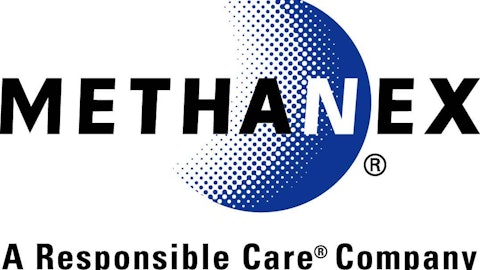Housing recovery debate
Housing recovery has been a point of debate for some time. Both residential and non-residential spending have climbed up as depicted by the rising house prices and Architectural Billing Index (ABI). Some believe that the housing market is on its way to a revival after the housing bubble burst in 2006. On the other hand, many believe that the rest of the economy is teetering away thereby suggesting that the ‘revival’ in housing market might be temporary.
How to check?
The Paints & Coating industry remains one of the main beneficiaries of the housing recovery. Let’s analyze a couple of players to judge whether the recovery is a strong one or not.
Sherwin-Williams Company (NYSE:SHW) is the first name that comes to my mind as soon as I think about paints. The company manufactures and distributes paints through its three core segments: Paint Stores (62% of sales), Consumer (18%), and Global (20%). The company operates more than 3,000 stores worldwide and caters to do-it-yourself (DIY) customers, contractors, and multi-national industrial manufacturers.

The company also issued weak guidance for 2013 (below the Street’s estimate). The sales growth was forecasted to be in 5-9% range as opposed to the Street’s estimate of 8% growth.
While Sherwin has a history of providing conservative guidance that it subsequently exceeds, Sherwin-Williams Company (NYSE:SHW) bulls are likely to be disappointed by the lack of a guidance raise heading into the company’s seasonally strong quarters, especially given Sherwin’s broad appeal for its leverage to a US housing recovery. Therefore, continued weakness in commercial construction and new housing end markets, as well as rising raw material prices, leave me on the sidelines.
Some more players
The Valspar Corporation (NYSE:VAL) is another chemical player that is exposed to construction activity in the US. The company has large positions in both architectural and industrial coatings. In the Paints segment (~40% of sales), Valspar primarily sells architectural paint in North America, China and Australia. In the Coatings segment (~53% of sales), the company supplies coatings to packaging (#1 global supplier), coil, wood (#1 in China) and general industrial end markets. The remainder of sales comes from specialty polymers, colorants and furniture protection.
The company is expected to report its earnings on May 14. The consensus estimates show that the company will make revenue of $1.05 billion and an EPS of $0.91. Again, analysts believe that paint demand remains pressured by the ongoing weakness in the housing market.
However, the stock can’t be called a sell given that the company has a defensive packaging business, which accounts for ~20% of total sales and ~10% of total sales come from China, which could offset potential slowing growth in other industrial markets. Falling petrochemical derivative prices should result in higher margins in 2013.
A story quite similar to The Valspar Corporation (NYSE:VAL) is that of PPG Industries, Inc. (NYSE:PPG). The giant coatings producer and the #2 global producer of paints and coatings, made an annual revenue of ~$15 billion in 2012.
PPG also makes a large chunk of its sales from paint and coatings. However, the end market of paints in this case is not only houses. It is also used in the automotive and aerospace industry. And we all know that both these industries are booming right now. Auto sales (SAAR) for April reached a five year high level. Similarly, companies like The Boeing Company (NYSE:BA) believe that the demand for commercial aircraft (small and fuel-efficient) is rising day by day.
Why I call PPG Industries, Inc. (NYSE:PPG) a story similar to The Valspar Corporation (NYSE:VAL) is because the stock is not a sell despite making a big chunk of sales through paint. Also, the company gets revenues from large flat glass and optical material, which helps it to diversify its revenue base.
My Foolish Take
Sherwin-Williams Company (NYSE:SHW) is definitely recommended as a sell given the weak forecast for the housing market. The Valspar Corporation (NYSE:VAL) seems to be a neutral call as the weakness in the paint market is balanced by its diversified revenue base. PPG Industries, Inc. (NYSE:PPG) is recommended as a buy given the growing end markets for its products.
The article Understanding Housing Recovery in the Language of Paint Industry originally appeared on Fool.com.
Copyright © 1995 – 2013 The Motley Fool, LLC. All rights reserved. The Motley Fool has a disclosure policy.

